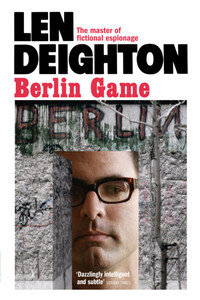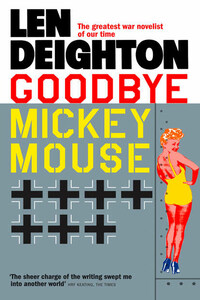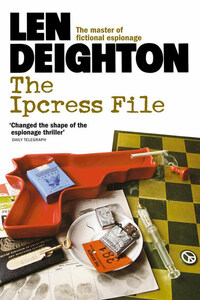In November 1989, my wife Isolde and I had the pleasure of being in the German capital at the fall of the Berlin Wall, where I photographed many images of young and old citizens chipping away at the Wall. Along with these I photographed a number of versions of ‘Berlin’ that had been spray-painted on the wall’s surface, as well as the signboard at ‘Checkpoint Charlie’.
There can have been no more potent symbol of division, or barrier, than the Berlin Wall and it would always be a perfect visual representation of the city of Berlin, where so much of this story takes place.
As Len Deighton’s protagonist, Bernard Samson, penetrates beyond the Wall into the Eastern sector I thought I would cut a door into the Wall to symbolize his furtive activities.
At the heart of every one of the nine books in this triple trilogy is Bernard Samson, so I wanted to come up with a neat way of visually linking them all. When the reader has collected all nine books and displays them together in sequential order, the books’ spines will spell out Samson’s name in the form of a blackmail note made up of airline baggage tags. The tags were drawn from my personal collection, and are colourful testimony to thousands of air miles spent travelling the world.
Arnold Schwartzman OBE RDI
Published by HarperCollinsPublishers Ltd
1 London Bridge Street
London SE1 9GF
www.harpercollins.co.uk
First published in Great Britain by Hutchinson & Co. (Publishers) Ltd 1983
Copyright © Pluriform Publishing Company BV 1983
Introduction copyright © Pluriform Publishing Company BV 2010
Cover designer’s note © Arnold Schwartzman 2010
Cover design and photography © Arnold Schwartzman 2010
Len Deighton asserts the moral right to be identified as the author of this work.
A catalogue copy of this book is available from the British Library.
This novel is entirely a work of fiction. The names, characters and incidents portrayed in it are the work of the author’s imagination. Any resemblance to actual persons, living or dead, events or localities is entirely coincidental.
All rights reserved under International and Pan-American Copyright Conventions. By payment of the required fees, you have been granted the non-exclusive, non-transferable right to access and read the text of this e-book on screen. No part of this text may be reproduced, transmitted, down-loaded, decompiled, reverse engineered, or stored in or introduced into any information storage and retrieval system, in any form or by any means, whether electronic or mechanical, now known or hereinafter invented, without the express written permission of HarperCollins.
Source ISBN: 9780008124984
Ebook Edition © March 2015 ISBN: 9780007387182
Version: 2018-05-08
Writers are frequently advised to shape their stories along conventional lines. This means simplify the plot-line, eliminate descriptive passages, emphasize and extend action, minimize characterization and forget sub-plots. This sort of well-intentioned advice is apt to transform a book into a film script. Not a bad move, you say. That’s true, unless you wanted to write a book.
Coming to writing at a time when the formalities of such instruction were unavailable I was likely to break one or the other of these rules: sometimes all of them in one go. I suppose many writers are drawn to the problems of characterization. That certainly was my prime interest; not just the characterization of the central characters but of spear-carriers too. Until Berlin Game I had fretted and struggled as I tried to retain the pace of the action while expanding the reality of the people in the story. To give my characters a real, or at least a convincing, life demanded more space. Did giving them a domestic dimension mean pressing the pause button in order to relate the dull routines of mortgages, electric bills, children’s ailments and traffic jams? No, that is not the way to treat your readers unless you just don’t care about them; and in that case you should be writing literary novels.
I have always been a planner. I remain in awe of writers who complete a book in ten days as friends of mine do. And even more wide-eyed to hear others proclaim that they customarily don’t know how their stories will end until they are writing the final chapter. I am far too timid for that kind of perilous pursuit.
My writing life is littered with the notes of abandoned stories, and Berlin Game had been balanced on the lid of the litterbin for a long time. The basic idea attracted me very much but there were problems that I’d not been able to crack. It was while on the final stages of














